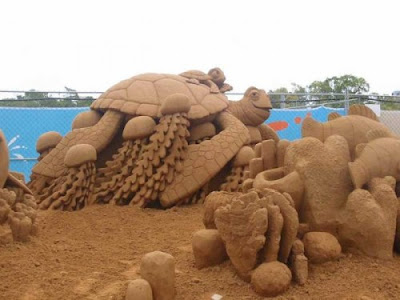Facts I Got
About Me

- Quintus Jerald Dsouza
- I'm a Friendly person, Love unique things in life, Magnetic Person
Saturday, 3 September 2011
Thursday, 25 August 2011
Sea Dragon - Leafy & Weedy Sea Dragons
The leafy sea dragon or Glauerts Seadragon, Phycodurus eques, is a marine fish in the family Syngnathidae, which also includes the seahorses. It is the only member of the genus Phycodurus. It is found along the southern and western coasts of Australia. The name is derived from the appearance, with long leaf-like protrusions coming from all over the body. These protrusions are not used for propulsion; they serve only as camouflage. The leafy sea dragon propels itself by means of a pectoral fin on the ridge of its neck and a dorsal fin on its back closer to the tail end. These small fins are almost completely transparent and difficult to see as they undulate minutely to move the creature sedately through the water, completing the illusion of floating seaweed.
Sea dragons are some of the most ornately camouflaged creatures on the planet. Adorned with gossamer, leaf-shaped appendages over their entire bodies, they are perfectly outfitted to blend in with the seaweed and kelp formations they live amongst.
Endemic to the waters off south and east Australia, leafy and weedy sea dragons are closely related to seahorses and pipefish. Leafies are generally brown to yellow in body color with spectacular olive-tinted appendages. Weedies have less flamboyant projections and are usually reddish in color with yellow spots.
Sea dragons have very long, thin snouts; slender trunks covered in bony rings; and thin tails which, unlike their seahorse cousins, cannot be used for gripping. They have small, transparent dorsal and pectoral fins that propel and steer them awkwardly through the water, but they seem quite content to tumble and drift in the current like seaweed. Leafies grow to a length of about 14 inches (35 centimeters), while the slightly larger weedies can grow up to 18 inches (46 centimeters) long.
As with sea horses, sea dragon males are responsible for childbearing. But instead of a pouch, like sea horses have, male sea dragons have a spongy brood patch on the underside of the tail where females deposit their bright-pink eggs during mating. The eggs are fertilized during the transfer from the female to the male. The males incubate the eggs and carry them to term, releasing miniature sea dragons into the water after about four to six weeks.
Sea dragons survive on tiny crustaceans such as mysids, or sea lice. It is not known if they are preyed upon by other animals. They are, however, frequently taken by divers seeking to keep them as pets. In fact, such takings shrank their numbers so critically by the early 1990s that the Australian government placed a complete protection on both species. Pollution and habitat loss have also hurt their numbers, and they are currently listed as near threatened.
Fast Facts about Leafy & Weedy Sea Dragon
Type: Fish
Diet: Omnivore
Size: Leafy, up to 13.8 in (35 cm), Weedy, up to 18 in (46 cm)
Wednesday, 24 August 2011
Sand Sculpture Art - Amazing, Beautiful, Stunning and Unique Sand Art
Sand art is the practice of modelling sand into an artistic form, such as a sand brushing, sand sculpture, sandpainting, or sand bottles. A sand castle is a type of sand sculpture resembling a miniature building, often a castle.
The two basic building ingredients, sand and water, are available in abundance on a sandy beach, so most sand play takes place there, or in a sandpit. Tidal beaches generally have sand that limits height and structure because of the shape of the sand grains. Good sand sculpture sand is somewhat dirty, having silt and clay that helps lock the irregular shaped sand grains together.
Sand castles are typically made by children, simply for the fun of it, but there are also sand sculpture contests for adults that involve large, complex constructions.
Subscribe to:
Posts (Atom)






















































